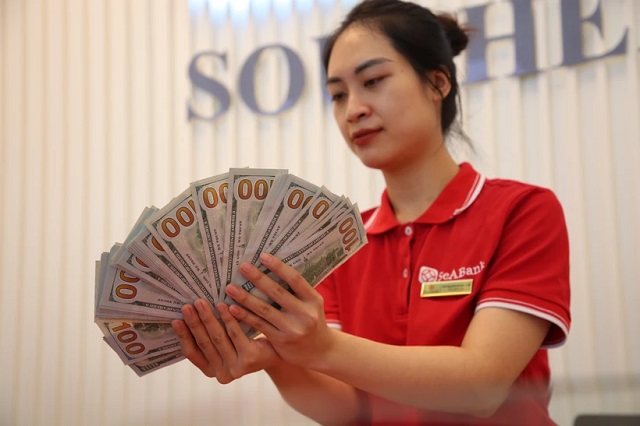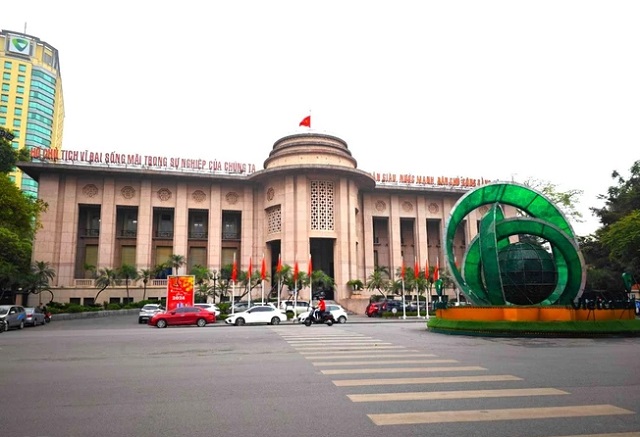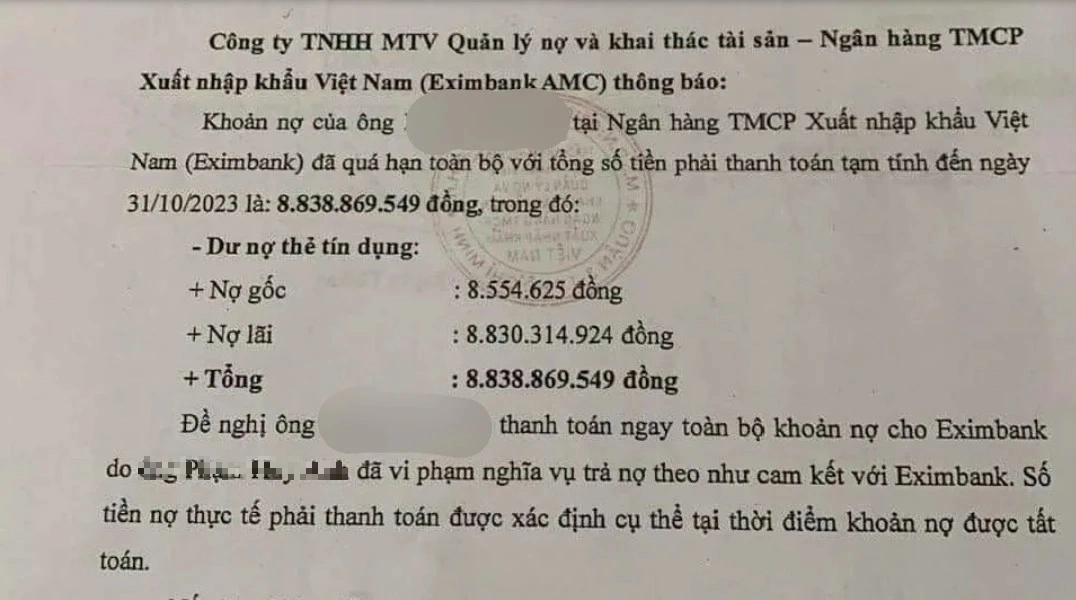Bank USD price plummets, falling by over 100 VND

Commercial bank exchange rates have dropped by approximately 380 VND/USD after 1 month. (Photo: Vietnam+)
|
Since the beginning of the third quarter, the USD index has been on a downward trend. The VND/USD exchange rate is expected to remain stable in the final months of the year. As a result, businesses that borrow in foreign currency or engage in import-export activities can breathe a sigh of relief as exchange rate fluctuations lessen.
Exchange rates continue to cool down
At the start of this week, exchange rates at commercial banks witnessed another significant drop, marking the fifth consecutive week of decline since July 22nd. The State Bank of Vietnam set the daily reference exchange rate for August 20th at 24,251 VND/USD, a decrease of 10 VND from the previous day.
Consequently, with a +/- 5% fluctuation band, the ceiling and floor rates applied by banks were 25,463 VND/USD and 23,038 VND/USD, respectively.
This morning (August 20th), the State Bank’s Foreign Exchange Trading Center maintained the buying and selling rates of USD at 23,400-25,450 VND/USD.
Many commercial banks also made substantial adjustments to their buying and selling rates, with changes ranging from 100 to 150 VND compared to the same period on the previous day.
According to our survey, Vietcombank listed the buying and selling rates at 24,710-25,080 VND/USD, a decrease of 130 VND on both sides compared to the previous day.
BIDV listed its buying and selling rates at 24,740-25,080 VND/USD, a reduction of 140 VND on both sides from the previous session.
Techcombank’s rates stood at 24,728-25,119 VND/USD, an 87 VND drop, while Eximbank’s rates were 24,710-25,140 VND/USD, with a decrease of 110 VND on the buying side and 100 VND on the selling side compared to the previous day.
Commercial bank USD rates have consistently dropped, settling at levels significantly lower than the ceiling rate set by the State Bank of Vietnam. According to a report from the State Bank of Vietnam, the Vietnamese dong had depreciated by nearly 5% against the USD since the beginning of 2024. However, by early August, this rate had improved to 3.85%. This indicates a decrease of about 380 VND/USD compared to the rates on July 27th.
Amid speculations of a Fed rate cut in September, Mr. Truong Van Phuoc, former Acting Chairman of the National Financial Supervisory Commission, noted that the US CPI for July 2024 fell to 3% – lower than the expected 3.1%. Meanwhile, the unemployment rate rose to 4.3% in July, up from 4.1% in June. These factors increase the likelihood of the Fed taking action to cut rates to prevent the US economy from sliding into a recession, despite some remaining doubts about the scale of the reduction.

Exchange rate stability has been maintained, ensuring a smooth foreign exchange market. This is a significant stability that Vietnam is upholding. (Photo: Vietnam+)
|
Domestically, stable economic growth and narrowing gold price differences between the domestic and international markets have contributed to easing speculative pressures on the exchange rate.
Mr. Dao Minh Tu, Permanent Vice Governor of the State Bank of Vietnam, asserted that the exchange rate stability has been maintained, and a smooth foreign exchange market ensured. This is a significant stability that Vietnam is upholding.
“With the State Bank’s management, the exchange rate remains stable, the foreign exchange market is smooth, and foreign currency balances are assured. This also ensures positive foreign currency status for commercial banks and meets the legitimate foreign currency demands of businesses and import-export activities,” said Mr. Tu.
Are businesses truly relieved of their burden?
Regarding the recent downward trend in exchange rates, Mr. Trinh Ba Ngoc, Director of Hanoi Industrial Trading and Service Investment Joint Stock Company, shared: “Even a slight decrease in the exchange rate can save our company tens to hundreds of millions of dongs. This, in turn, enhances our competitiveness in terms of pricing.”
Similarly, a representative of a company specializing in importing and distributing measurement equipment revealed that their monthly import value amounts to 11 billion VND, with transactions conducted in foreign currency. Thanks to the recent decline in the VND/USD exchange rate, the cost of each order has decreased by 2-4% compared to the peak period.
“Currently, the lower USD rate has resulted in reduced input costs for orders, benefiting both consumers and businesses. With lower output prices, we can also increase our sales and, consequently, our revenue,” the company representative informed.
The decreasing trend in exchange rates has helped businesses enhance their competitiveness and seek out new orders.
Mr. Can Van Luc, a member of the National Financial and Monetary Policy Advisory Council, evaluated: “A lower exchange rate benefits us when repaying foreign debts in USD. It also improves foreign investment, as foreign investors perceive reduced interest rate differentials and a stable exchange rate, encouraging investment in Vietnam.”
 The recent downward trend in exchange rates has helped businesses enhance their competitiveness and seek out new orders. (Photo: Vietnam+)
|
From a business perspective, listed companies on the stock exchange are keenly aware of the importance of exchange rate stability in maintaining their production activities and securing foreign currency for import-export operations. A rising exchange rate leads to exchange rate differences, negatively impacting companies’ profit and loss calculations and, consequently, their profits. A stronger USD also affects businesses with USD-denominated loans and import needs.
Forecasting the VND/USD exchange rate trend from now until the end of 2024, many experts concur that exchange rate tensions are easing as the managing agency has introduced a series of measures to stabilize the rate. These include net VND absorption in the interbank market to reduce interest rate differentials, immediate foreign currency sales to commercial banks to balance their foreign currency status, and gold auction sessions amid rising gold prices in the domestic market. These measures are gradually yielding positive results.
However, experts also point out that in the coming months, the USD may be influenced by the US political landscape as the presidential election draws near. Therefore, it is crucial to monitor other key factors that could impact the currency.
In the domestic market, the exchange rate is influenced not only by global market trends but also by domestic demand. Typically, USD demand increases in the latter part of the third quarter and the beginning of the fourth quarter due to the need for machinery and raw material imports for year-end export orders.
Despite these positive signals, the challenge of high USD interest rates remains significant. The State Bank of Vietnam has affirmed that it will continue to manage the exchange rate flexibly and proactively to ensure economic stability.
Thuy Ha
New currency exchange service: Rare small denominations
The demand for exchanging small denominations of money increases during the Lunar New Year, but the availability of small bills is limited. The familiar “money exchange kiosks” are also gradually disappearing from this service.
Vietnam Airlines sees promising results in its quest for financial balance
By the end of 2023, this business has incurred a total loss of over 5.8 trillion VND despite a 30% increase in revenue.





















